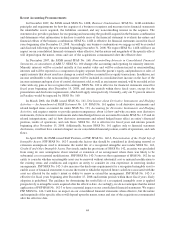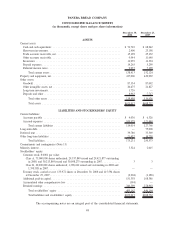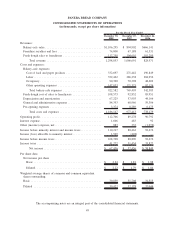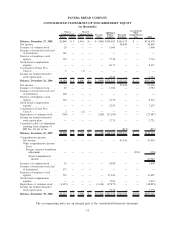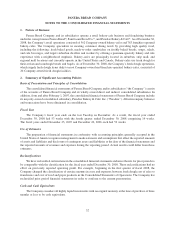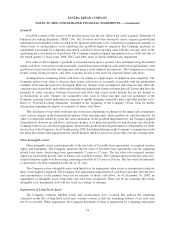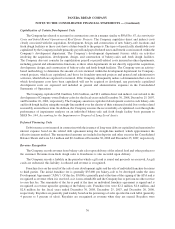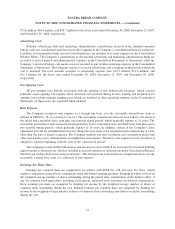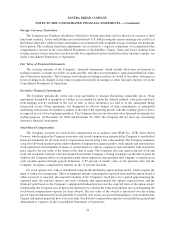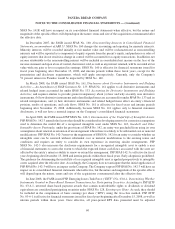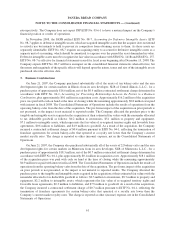Panera Bread 2008 Annual Report Download - page 61
Download and view the complete annual report
Please find page 61 of the 2008 Panera Bread annual report below. You can navigate through the pages in the report by either clicking on the pages listed below, or by using the keyword search tool below to find specific information within the annual report.Goodwill
Goodwill consists of the excess of the purchase price over the fair value of net assets acquired. Statement of
Financial Accounting Standards (“SFAS”) No. 142, Goodwill and Other Intangible Assets, requires goodwill and
indefinite-lived intangible assets recorded in the financial statements to be evaluated for impairment annually or
when events or circumstances occur indicating that goodwill might be impaired. The Company performs its
impairment assessment by comparing discounted cash flows from reporting units with the carrying value of the
underlying net assets inclusive of goodwill. The Company completed annual impairment tests as of the first day of
the fourth quarter of fiscal years 2008, 2007, and 2006, none of which identified any impairment.
Fair value of the Company’s goodwill is estimated based upon a present value technique using discounted
future cash flows, forecasted over the reasonably assured lease term for bakery-cafes and fresh dough facilities, with
growth rates forecasted for the reporting units and using a credit adjusted discount rate. The Company uses current
results, trends, future prospects, and other economic factors as the basis for expected future cash flows.
Assumptions in estimating future cash flows are subject to a high degree of judgment and complexity. The
Company makes every effort to forecast these future cash flows as accurately as possible with the information
available at the time the forecast is developed. However, changes in the assumptions and estimates may affect the
carrying value of goodwill, and could result in additional impairment charges in future periods. Factors that have the
potential to create variances between forecasted cash flows and actual results include but are not limited to
(i) fluctuations in sales volumes, (ii) commodity costs, such as wheat and fuel; and (iii) acceptance of the
Company’s pricing actions undertaken in response to rapidly changing commodity prices and other product costs.
Refer to “Forward-Looking Statements” included in the beginning of the Company’s Form 10-K for further
information regarding the impact of estimates of future cash flows.
The calculation of fair value could increase or decrease depending on changes in the inputs and assumptions
used, such as changes in the financial performance of the reporting units, future growth rate, and discount rate. In
order to evaluate the sensitivity of the fair value calculations on the goodwill impairment test, the Company applied
a hypothetical decrease in cash flows, and made changes to its projected growth rate and discount rate which the
Company believes are considered appropriate. Based on the goodwill analysis performed as of September 24, 2008,
the first day of the Company’s fiscal fourth quarter 2008, the outlined changes in the Company’s assumptions would
not affect the results of the impairment test, and all markets still have an excess of fair value over the carrying value.
Other Intangible Assets
Other intangible assets consist primarily of the fair value of favorable lease agreements, re-acquired territory
rights, and trademarks. The Company amortizes the fair value of favorable lease agreements over the remaining
related lease terms, which range from approximately 3 years to 17 years. The fair value of re-acquired territory
rights was based on the present value of bakery-cafe cash flow streams. The Company amortizes the fair value of re-
acquired territory rights over the average remaining useful life of 13 years to 20 years. The fair value of trademarks
is amortized over their estimated useful life of 22 years.
The Company reviews intangible assets with finite lives for impairment when events or circumstances indicate
these assets might be impaired. The Company tests impairment using historical cash flows and other relevant facts
and circumstances as the primary basis for an estimate of future cash flows. As of December 30, 2008, no
impairment of intangible assets with finite lives had been recognized. There can be no assurance that future
intangible asset impairment tests will not result in a charge to earnings.
Impairment of Long-Lived Assets
The Company evaluates whether events and circumstances have occurred that indicate the remaining
estimated useful life of long-lived assets may warrant revision or that the remaining balance of an asset may
not be recoverable. When appropriate, the Company determines if there is impairment by comparing anticipated
54
PANERA BREAD COMPANY
NOTES TO THE CONSOLIDATED FINANCIAL STATEMENTS — (Continued)


